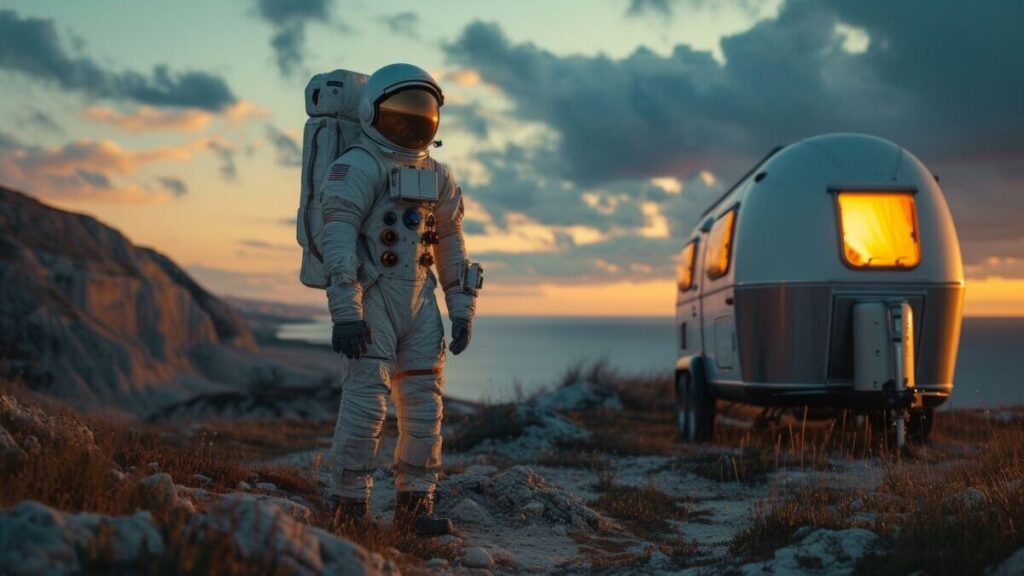Introduction
In recent years, space tourism has moved from science fiction to reality. What once seemed like an unattainable dream is a booming industry, with billionaires racing to send civilians beyond Earth’s atmosphere. Companies like SpaceX, Blue Origin, and Virgin Galactic have spearheaded commercial spaceflight, promising an extraordinary experience for the ultra-wealthy.
- Introduction
- The Rise of Space Tourism
- Negative Impacts of Space Exploration on the Environment
- Conflicting Priorities: Science vs. Tourism
- Environmental Concerns and Their Effect on Research
- Space Debris: A Growing Threat
- Pollution and Climate Change Concerns
- Limited Access to Space for Scientists
- Safety Concerns and Their Effect on Space Missions
- Public Perception and Media Influence
- Potential Solutions and Balancing Both Worlds
- Why Is Space Exploration Dangerous?
- Conclusion
While this progress excites many, it raises serious concerns—especially regarding scientific discovery. Historically, space exploration has been driven by pursuing knowledge, advancing technology, and unlocking the universe’s secrets. But as space becomes a playground for the rich, it threatens to overshadow vital research, limit scientific access, and increase environmental damage.
This article explores the darker side of space tourism and how it affects humanity’s quest for scientific advancement.
The Rise of Space Tourism
Traveling to space for leisure seemed impossible a few decades ago. However, since the early 2000s, private companies have worked toward commercial space travel. What started with government-funded missions in the 20th century is now a billion-dollar industry.
Elon Musk’s SpaceX, Jeff Bezos’ Blue Origin, and Richard Branson’s Virgin Galactic are at the forefront of this revolution. They promise suborbital and orbital flights, moon missions, and even the possibility of Mars colonization. As a result, space tourism is no longer just a concept—it’s a reality.
While this innovation is impressive, it also diverts focus from scientific research. Governments once prioritized space exploration to enhance knowledge and technology. Financial and technological resources are increasingly directed toward making space accessible for a privileged few rather than for scientific advancement.
Negative Impacts of Space Exploration on the Environment
While space tourism is an engineering marvel, its environmental impact is a growing concern. Every rocket launch releases pollutants into the upper atmosphere, where they remain for years, affecting Earth’s climate.
- Carbon Emissions: Rockets burn enormous amounts of fuel, releasing CO₂ and other greenhouse gases contributing to global warming.
- Ozone Layer Damage: Some rocket engines emit chlorine-based compounds that directly harm the ozone layer, increasing exposure to harmful ultraviolet radiation.
- Pollution in the Upper Atmosphere: Unlike aircraft emissions, which dissipate relatively quickly, rocket emissions linger, disrupting the atmospheric balance.
As the number of launches increases, so do their long-term effects on climate stability. If space tourism is not regulated, it could accelerate global warming, ironically claiming to advance human civilization.
Conflicting Priorities: Science vs. Tourism
Scientific missions and space tourism serve entirely different purposes. Space agencies like NASA, ESA, and Roscosmos focus on research—studying planetary systems, conducting medical experiments, and monitoring Earth’s climate.
On the other hand, commercial companies prioritize profit. They sell experiences to wealthy individuals while marketing space as a luxury adventure. This shift has led to competition for launch windows, spacecraft, and space station accommodations.
For instance, scientific payloads and experiments require precise launch schedules, but space tourism missions often take precedence due to commercial demand. This competition reduces the availability of resources for researchers, delaying crucial scientific discoveries.
Environmental Concerns and Their Effect on Research
Frequent rocket launches come at a significant environmental cost. Each launch releases massive amounts of carbon dioxide, water vapor, and other pollutants into the upper atmosphere.
Scientists studying climate change have raised concerns that increased rocket activity could impact atmospheric composition, ozone layer depletion, and global temperatures. The irony? Space tourism may contribute to the climate issues space agencies are trying to study and solve.
Additionally, rockets leave behind space debris—fragments of discarded rocket stages, satellites, and other materials. These remnants pose a growing threat to both future space missions and scientific satellites.
Space Debris: A Growing Threat
Every rocket launch leaves behind remnants in orbit. While this has always been a concern, space tourism significantly increases the number of launches, meaning more debris is left behind.
This debris endangers research satellites, space telescopes, and the International Space Station (ISS). If a tiny piece of debris traveling at high speed collides with a satellite, it can cause irreversible damage, disrupting ongoing astronomy, meteorology, and telecommunications studies.
As space becomes more crowded, the risk of collisions increases. A major accident could trigger a chain reaction, creating more debris and making certain orbits unusable for scientific research.
Pollution and Climate Change Concerns
One of the most overlooked consequences of space tourism is its impact on Earth’s climate. Every rocket launch burns tons of fuel, releasing harmful pollutants into the upper atmosphere. Unlike aircraft emissions dissipating within days, rocket emissions linger for years, disrupting atmospheric chemistry.
A primary concern is the depletion of the ozone layer. Solid rocket propellants release chlorine, which actively breaks down ozone molecules. The ozone layer protects life on Earth from harmful ultraviolet radiation, and any disruption could have long-term consequences.
Additionally, rocket engines’ black carbon (soot) absorbs sunlight, contributing to atmospheric heating. Scientists worry that the cumulative effect of frequent launches could alter weather patterns and increase global temperatures. If space tourism continues unchecked, its environmental cost could outweigh its technological benefits, making it a counterproductive industry for humanity’s future.
Limited Access to Space for Scientists
With the rise of space tourism, scientists are finding it harder to access crucial space resources. Traditionally, government space agencies and research institutions have worked together to send scientific equipment, satellites, and researchers to space. However, the surge in commercial spaceflight has changed the game.
Launch costs have skyrocketed due to increased demand, making it more expensive for researchers to send experiments into orbit. Private companies prioritize paying tourists over scientific payloads because they generate more revenue. As a result, important projects—such as climate research, medical studies, and astronomical observations—face delays or cancellations.
Furthermore, space stations like the ISS now accommodate private tourists, reducing the available slots for scientists conducting long-term research. If space continues to be privatized at this rate, future generations of scientists may struggle to access the very domain they strive to understand.
Safety Concerns and Their Effect on Space Missions
Space tourism isn’t just about sending people on joyrides—it also introduces significant safety risks. Space travel is inherently dangerous, even for highly trained astronauts. The presence of inexperienced civilians in orbit increases the likelihood of accidents, which could jeopardize their lives and critical scientific missions.
For example, an emergency on a tourist flight near the ISS could disrupt research operations, diverting resources from science to rescue missions. A catastrophic failure—such as an explosion or spacecraft malfunction—could result in deadly debris, endangering other missions and permanently damaging space infrastructure.
Safety regulations for commercial spaceflight are still developing, meaning many risks remain unaddressed. Until strict policies are implemented, the intersection of space tourism and scientific research will remain dangerous.
Public Perception and Media Influence
The media plays a crucial role in shaping public perception of space tourism. When a billionaire or celebrity embarks on a space trip, it becomes a global spectacle, overshadowing groundbreaking scientific discoveries.
For instance, it dominated headlines when William Shatner—the actor who played Captain Kirk in Star Trek—went to space aboard a Blue Origin flight. At the same time, astronomers made significant advancements in exoplanet research, but their work received minimal attention.
This media bias leads to a shift in priorities. Governments and investors are more inclined to fund commercial space ventures because they generate more publicity and excitement. Meanwhile, underfunded scientific projects struggle to gain traction despite their long-term importance for humanity’s progress.
Potential Solutions and Balancing Both Worlds
Despite the challenges posed by space tourism, it’s possible to strike a balance between commercial space travel and scientific discovery. Here are some potential solutions:
- Investment in Sustainable Spaceflight: Companies should develop eco-friendly rocket fuels and propulsion systems to minimize environmental damage.
- Regulating Space Debris: Governments and agencies must enforce stricter guidelines on space junk removal and collision prevention.
- Prioritizing Science-Based Missions: Space agencies should ensure that scientific research retains priority over commercial tourism.
- Public Awareness Campaigns: Educating the public about the importance of scientific space exploration can shift media focus toward meaningful discoveries.
- Collaborations Between Private and Public Sectors: Partnerships between space agencies and commercial enterprises can ensure that tourism profits contribute to research and technological advancements.
If these solutions are implemented, humanity can enjoy the benefits of space tourism while preserving the integrity of scientific exploration.
Why Is Space Exploration Dangerous?
Space travel is inherently risky, even for highly trained astronauts. When untrained civilians enter the equation, the dangers increase significantly.
- Rocket Malfunctions: Unlike commercial airplanes, rockets operate under extreme conditions. Any minor failure can result in catastrophic explosions.
- Health Risks: The human body is not built for space. Zero gravity affects the heart, muscles, and bones, making long-term space exposure dangerous.
- Space Debris Collisions: The more objects we send into space, the greater the risk of collisions. A single impact with high-speed debris could destroy an entire spacecraft.
The more space tourism expands, the greater the risks—not just for passengers but also for ongoing scientific missions.
Conclusion
While space tourism represents a thrilling new frontier, it has significant drawbacks. The shift from scientific exploration to commercial travel risks undermining vital research, limiting access for scientists, and contributing to environmental degradation.
The increasing presence of tourists in space threatens to overshadow essential scientific efforts, from climate studies to astronomical research. Safety concerns, space debris, and media bias further complicate the relationship between commercial and research-driven spaceflight.
However, by implementing responsible policies, investing in sustainable technology, and balancing tourism and exploration, we can ensure that space remains a resource for all humanity—not just the wealthy elite.


